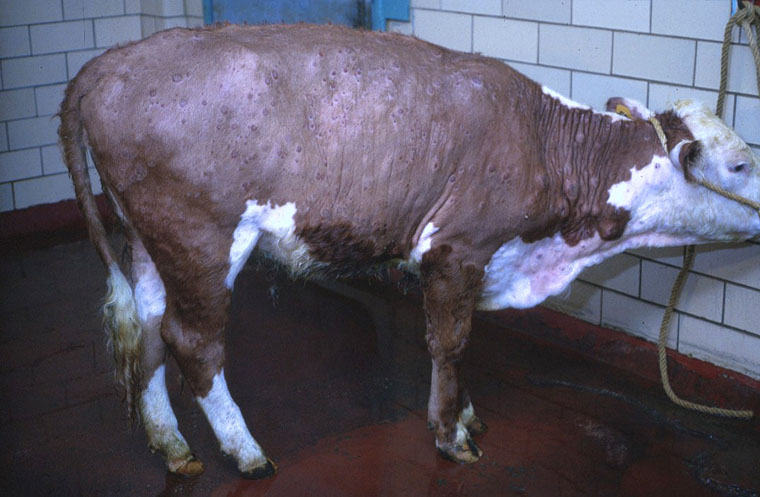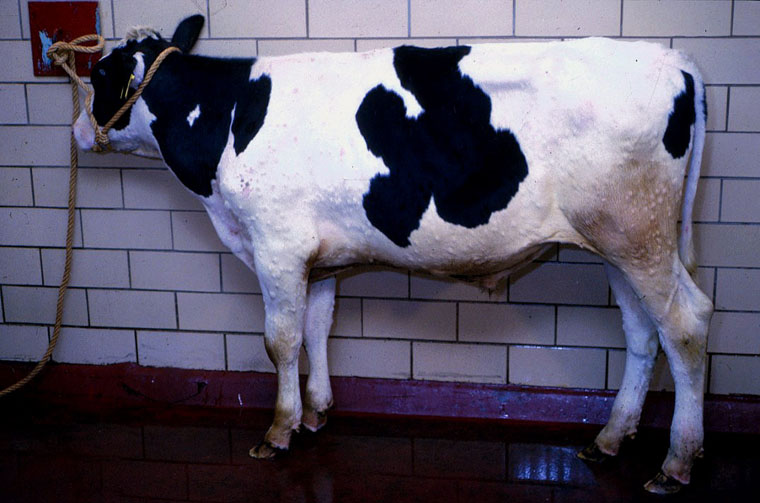
Lumpy skin disease
ALERT
Look out for lumpy skin disease
- A report of lumpy skin disease (LSD) in Indonesia in March 2022 has increased the risk to Australia, which remains free of the disease.
- Lumpy skin disease is primarily spread by biting insects such as flies and mosquitoes and possibly ticks. This makes it harder to protect our Australian borders from incursions of the disease.
- The NSW Government urges everyone to remain vigilant for signs of LSD in cattle and buffalo.
- If you suspect LSD, report it immediately to the Emergency Animal Disease Watch Hotline, 1800 675 888.
- Veterinarians requiring more information on sampling and testing requirements can refer to Lumpy skin disease (LSD) in cattle.
 Lumpy skin disease (LSD) is a highly infectious viral disease that affects all breeds of cattle and water buffalo. It does not affect other types of livestock or humans.
Lumpy skin disease (LSD) is a highly infectious viral disease that affects all breeds of cattle and water buffalo. It does not affect other types of livestock or humans.
LSD is primarily spread by biting insects. Insects such as mosquitoes, biting flies and possibly ticks mechanically transfer the virus. It can also be spread through direct contact between animals via secretions and excretions. Contaminated feed, water, vehicles and iatrogenic means (for example, repeated use of needles on different animals) can all spread the disease.
In addition, LSD may be shed in semen and may be present in milk of infected animals.
Lumpy skin disease in Australia
LSD is an exotic animal disease and Australia currently maintains a disease-free status for LSD.
The geographical distribution of LSD has been rapidly expanding through south Asia in 2021. In March 2022 Indonesia reported cases of lumpy skin disease on the island of Sumatra.
We are now on high alert for spread of the disease to Australia from the region.
An incursion of LSD would have severe negative animal welfare and economic implications along with substantial trade impacts.
Who do I call?
Lumpy skin disease is a national notifiable disease which means an animal showing suspect signs of the disease must be reported to a Local Land Services District Veterinarian (DV) on 1300 795 299 or the Emergency Animal Disease Watch Hotline on 1800 675 888.
Lumpy skin disease in cattle
Clinical signs
 Animals infected with the disease present with fever, depression, and characteristic skin nodules.
Animals infected with the disease present with fever, depression, and characteristic skin nodules.
Once in a herd, the disease is very difficult to eradicate due to subclinical infections and the presence of insects capable of spreading the virus.
Clinical signs include:
- Firm raised skin nodules up to 50mm in diameter, distributed around the head, neck, genitals and limbs. Nodules can develop on any part of the body.
- Scabs develop in the centre of the nodules after which the scabs fall off, leaving large holes that may become infected.
- Swelling of limbs, brisket and genitals may occur
- Reluctance to move and eat
- Nasal and ocular discharges
- Enlarged superficial lymph nodes
- Drop in milk production
- Abortion
Post-mortem signs of LSD
Typical post-mortem findings include:
- Extensive greyish-pink skin nodules with caseous necrotic centres,
- Similar nodules may be found in the nasopharynx, trachea, bronchi, lungs, rumen, abomasum, renal cortex, testicles and uterus,
- Swollen, congested lymph nodes with petechial haemorrhages.
Diagnosing lumpy skin disease
- A thorough clinical examination, carried out by a veterinarian, is considered as an effective surveillance tool for LSD.
- The incubation period is between 4 and 14 days however the OIE Terrestrial Animal Health Code describes the incubation period as 28 days.
- Skin nodules, scabs and crusts contain high amounts of LSD virus. Virus can be isolated from this material for 35 days and possibly longer.
- LSD virus is found in the blood (viraemia) from approximately 7-21 days post infection.
Samples to collect
The NSW Animal and Plant Health Laboratories (APHL) at the Elizabeth Macarthur Agricultural Institute has provided the following advice for taking samples for LSD exclusion:
Live cattle
7-10mL/animal of serum and EDTA from a least 10 live, clinically affected animals and 10 in contact animals.
- The following samples should be taken for PCR exclusion testing:
- Skin Lesions
- Biopsies
- Scabs
- Scrapings
- Vesicular Fluid
- Saliva and Nasal Swabs
- Whole Blood in EDTA
- Antibody testing can be undertaken on serum.
- Virus isolation to be carried out on whole blood in Heparin
Post-mortem samples
Fresh and fixed tissue from characteristic skin lesions as well as internal lesions if present and regional lymph nodes.
Transporting samples
- Chill blood samples and unpreserved tissue samples at either 4°C or with ice bricks.
- Do not freeze samples at -20°C as it reduces the sensitivity of virus isolation testing.
- Place swab samples in transport media (PBGS) or in saline if other media is unavailable.
- Send samples in appropriate packaging via courier to the NSW APHL:
NSW Animal and Plant Health Laboratories
Elizabeth Macarthur Agricultural Institute (EMAI)
Woodbridge Road
Menangle NSW 2568
Phone: 1800 675 623
Protecting cattle:
Biting flies and mosquitoes as well as ticks play a major role in spreading LSD between animals on the farm and between farms.
The best way to protect your cattle is by developing and implementing an integrated insect management plan. This involves targeting all stages of the stable fly and mosquito life cycles to break the breeding cycle. It also needs to consider tick control.
Effective insect management on-farm includes:
- Monitoring larval and adult fly and mosquito numbers to know when to take action
- Environmental management to reduce the number of breeding and resting sites
- For example, fill potholes, remove standing water from containers, and ensure drains are free flowing
- Applying larvicide control in large bodies of water
- Applying adulticide control, such as residual spraying and fogging
- Maintaining chemical and mosquito control records
NOTE:
- ALWAYS use chemicals STRICTLY as per the product label
- SEEK PROFESSIONAL ADVICE if you are unsure about how to use a chemical
- CHEMICAL RESIDUES IN CATTLE ARE A TRADE AND FOOD QUALITY RISK
- MISUSE OF CHEMICALS CAN CREATE ENVIRONMENTAL RISKS TO BEES, WILDLIFE, AQUATIC LIFE AND PEOPLE
For more information on vector control for cattle, refer to:
For more information:
- Lumpy skin disease - information for vets PDF, 545.77 KB
- Department of Agriculture Water and Environment: Lumpy skin disease or Emergency Animal Disease Bulletin No. 121
- Animal Health Australia Website: Informing EAD Responses - AUSVETPLAN - Animal Health Australia – Lumpy skin disease response strategy
- OIE Technical Disease Card: lumpy skin disease
- FAO Lumpy skin disease Field Manual

